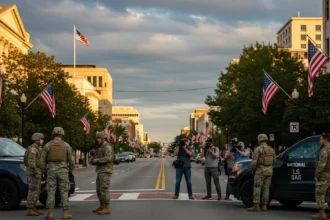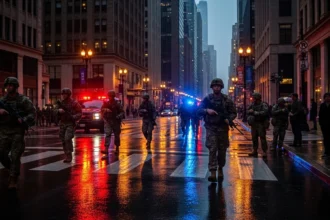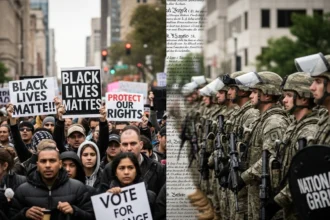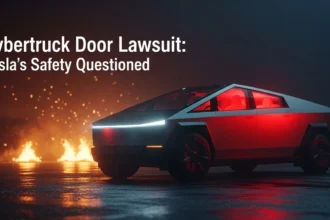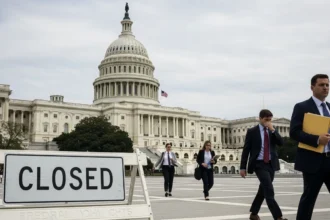In 2025, President Donald Trump’s aggressive immigration crackdown and unprecedented use of the Insurrection Act have triggered a wave of lawsuits and state defiance. Governors, mayors, and civil rights organizations are battling what they call an “executive overreach that militarizes America’s borders and streets.”
- 1. The 2025 Border Crackdown: Federal Power vs. State Resistance
- 2. Invoking the Insurrection Act: Troops in American Cities
- 3. State Governors Draw a Line
- 4. Legal Experts Weigh In: Is This Even Legal?
- 5. The Court Battles Begin
- 6. Public Backlash and Political Divide
- 7. What’s Next: The Fight for Constitutional Boundaries
Trump’s two-pronged strategy—a border enforcement surge and a domestic troop deployment—has become the defining legal and political storm of his second term.
👉 Related: Trump Threatens Use of Insurrection Act to Send Troops Into U.S. Cities
1. The 2025 Border Crackdown: Federal Power vs. State Resistance
The President’s “Border Sovereignty Directive,” signed in January 2025, ordered the deployment of thousands of National Guard troops to southern border states and authorized local enforcement partnerships to detain undocumented migrants. While Texas and Florida cheered the move, states like California, New Mexico, and Illinois declared it unconstitutional.
Critics argue the directive bypasses longstanding immigration law, centralizing power in the executive branch and undermining federal–state cooperation. Immigration advocacy groups quickly filed suit, arguing that the policy violates the Tenth Amendment and federal separation of powers.
According to reporting from Newsphone, the administration’s strategy has created “a nationwide network of enforcement zones” that blur the line between border control and domestic policing.
👉 Read more: Trump’s 2025 Border Crackdown Faces State Resistance
2. Invoking the Insurrection Act: Troops in American Cities
In a stunning move, President Trump invoked the Insurrection Act of 1807 to deploy federal troops to several U.S. cities, citing “civil unrest and widespread lawlessness” following nationwide protests over immigration raids.
The order authorized federal forces in Chicago, Los Angeles, and Portland—all Democratic-led cities whose governors refused to assist with the crackdown. The administration defended the action as necessary to “restore order,” but legal experts say the justification was thin and politically charged.
Civil rights groups, including the ACLU and Protect Democracy, filed emergency motions in federal court, calling the move “a direct assault on the Constitution’s balance of powers.”
The Insurrection Act, traditionally used to quell violent insurrections or rebellions, has rarely been invoked in peacetime—and never against states actively opposing federal immigration enforcement.
3. State Governors Draw a Line
Governors from Illinois, California, and Oregon issued joint statements condemning the President’s use of federal troops within their borders, arguing that it undermines both state sovereignty and civil liberties.
Illinois Governor J.B. Pritzker said,
“Deploying troops into our cities over immigration enforcement is not just an overreach — it’s a provocation. This is a moment to defend the Constitution, not surrender it.”
In response, the Trump administration threatened to withhold federal law enforcement grants and border security funding from non-cooperative states — escalating the standoff into a federal-state constitutional clash.
4. Legal Experts Weigh In: Is This Even Legal?
Scholars are sharply divided on whether the President’s actions are constitutional.
- Supporters claim the Insurrection Act grants broad authority to use military force in cases of “domestic violence” that hinder federal law enforcement.
- Opponents argue that immigration enforcement is a civil policy issue, not a rebellion or insurrection, and that Trump’s use of the Act stretches its intent beyond recognition.
Professor Elaine Kamarck of the Brookings Institution noted,
“This isn’t about rebellion—it’s about control. The president is using emergency powers to reframe political opposition as insurrection.”
5. The Court Battles Begin
In March 2025, a coalition of states filed a joint lawsuit in the D.C. Circuit challenging the constitutionality of the Insurrection deployment and the Border Sovereignty Directive. The lawsuits argue that Trump’s actions violate the Posse Comitatus Act, which restricts the use of federal military forces in domestic law enforcement.
Meanwhile, the Supreme Court has fast-tracked a related case questioning the limits of executive emergency authority. The outcome could define how far a president can go in asserting military or enforcement powers within U.S. borders.
If the courts uphold Trump’s interpretation, it could mark the largest expansion of executive power since World War II.
6. Public Backlash and Political Divide
Public reaction has split sharply along partisan lines.
- Conservatives argue Trump is finally “restoring law and order” and acting decisively where prior administrations failed.
- Progressives see it as a constitutional crisis, comparing it to the early 1970s’ domestic surveillance abuses.
Protests have erupted in several major cities, with demonstrators carrying signs reading “This Is Not a War Zone” and “No Troops in Our Streets.”
Even some Republican governors, wary of the precedent, have expressed concern that federal militarization could one day be used against them.
7. What’s Next: The Fight for Constitutional Boundaries
The legal fight is far from over.
With appeals pending and the 2026 election season approaching, the courts’ rulings on the Insurrection Act and border powers could not only shape Trump’s presidency but also redefine executive authority for decades.
Legal analysts warn that if left unchecked, these moves could normalize the use of military power in civilian governance, eroding the traditional wall between civil and military authority in the United States.
Conclusion: A Test of American Federalism
At its core, the 2025 clash between President Trump and state governments isn’t just about immigration or protests — it’s about who holds power in a divided republic.
As one constitutional lawyer put it,
“This is the most significant federalism fight since the Civil Rights era. The question is whether the rule of law — or the rule of force — will prevail.”
The outcome of these cases will not only decide the fate of Trump’s policies but may redefine the limits of presidential authority for generations.



